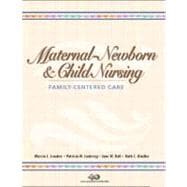
| Preface | p. xxix |
| Acknowledgments | p. xxxiii |
| Reviewers | p. xxxv |
| About the Authors | p. xxxvii |
| A Guide to Maternal-Newborn and Child Nursing | p. xxxix |
| Special Features | p. xliii |
| Introductory Concepts | p. 1 |
| Maternal, Newborn, and Child Health Nursing | p. 3 |
| The Reproductive Years and Beyond | p. 19 |
| Reproductive Anatomy and Physiology | p. 21 |
| Women's Health Care | p. 43 |
| Special Reproductive Issues for Families | p. 81 |
| Pregnancy and Family | p. 107 |
| Conception and Fetal Development | p. 109 |
| Preparation for Parenthood | p. 131 |
| Physical and Psychologic Changes of Pregnancy | p. 142 |
| Antepartal Nursing Assessment | p. 159 |
| The Expectant Family: Needs and Care | p. 181 |
| Adolescent Pregnancy | p. 206 |
| Maternal Nutrition | p. 218 |
| Pregnancy at Risk: Pregestational Problems | p. 234 |
| Pregnancy at Risk: Gestational Onset | p. 259 |
| Assessment of Fetal Status | p. 292 |
| Birth and the Family | p. 307 |
| Processes and Stages of Labor and Birth | p. 309 |
| Intrapartal Nursing Assessment | p. 331 |
| The Family in Childbirth: Needs and Care | p. 354 |
| Pain Relief Therapies During Birth | p. 381 |
| Childbirth at Risk | p. 393 |
| Birth-Related procedures | p. 425 |
| The Postpartal Childbearing Family and Newborn | p. 443 |
| Postpartal Adaptation and Nursing Assessment | p. 445 |
| The Postpartum Family: Needs and Care | p. 463 |
| The Postpartal Family at Risk | p. 482 |
| The Physiologic Responses of the Newborn to Birth | p. 506 |
| Nursing Assessment of the Newborn | p. 526 |
| Normal Newborn: Needs and Care | p. 566 |
| Newborn Nutrition | p. 586 |
| The Newborn at Risk: Conditions Present at Birth | p. 605 |
| The Newborn at Risk: Birth-Related Stressors | p. 641 |
| Home Care of the Postpartum Family | p. 682 |
| Care and Needs of Children | p. 703 |
| Infant, Child, and Adolescent Nutrition | p. 705 |
| Growth and Development | p. 727 |
| Pediatric Assessment | p. 764 |
| Nursing Considerations for the Hospitalized Child | p. 815 |
| Nursing Considerations for the Child in the Community | p. 838 |
| Social and Environmental Influences on the Child | p. 861 |
| The Child with a Life-Threatening Illness or Injury | p. 894 |
| Pain Assessment and Management in Children | p. 913 |
| Caring for Children with Alterations in Health Status | p. 993 |
| The Child with Alterations in Fluid, Electrolyte, and Acid-Base Balance | p. 935 |
| The Child with Alterations in Immune Function | p. 969 |
| The Child with Infectious and Communicable Diseases | p. 992 |
| The Child with Alterations in Respiratory Function | p. 1022 |
| The Child with Alterations in Cardiovascular Function | p. 1065 |
| The Child with Alterations in Hematologic Function | p. 1101 |
| The Child with Alterations in Cellular Growth | p. 1121 |
| The Child with Alterations in Gastrointestinal Function | p. 1159 |
| The Child with Alterations in Genitourinary Function | p. 1209 |
| The Child with Alterations in Eye, Ear, Nose, and Throat Function | p. 1242 |
| The Child with Alterations in Neurologic Function | p. 1272 |
| The Child with Alterations in Musculoskeletal Function | p. 1317 |
| The Child with Alterations in Endocrine Function | p. 1349 |
| The Child with Alterations in Skin Integrity | p. 1383 |
| The Child with Alterations in Mental Health Function | p. 1418 |
| Selected Maternal-Newborn Laboratory Values | p. 1446 |
| Selected Normal Pediatric Laboratory Values | p. 1447 |
| Physical Growth Charts | p. 1453 |
| Conversions and Equivalents | p. 1463 |
| Actions and Effects of Selected Drugs during Breastfeeding | p. 1464 |
| Common Abbreviations in Maternal-Newborn and Women's Health Nursing | p. 1466 |
| Common Abbreviations in Nursing Care of Children | p. 1468 |
| Family Assessment | p. 1470 |
| Guidelines for Working with Deaf Clients and Interpreters | p. 1471 |
| Recommended Dietary Allowances for Childhood and Adolescence | p. 1472 |
| Recommended Dietary Allowances for Females, Pregnancy, and Lactation | p. 1474 |
| Standards for Maternal-Newborn and Child Health Nursing | p. 1475 |
| West Nomogram-Body Surface Area | p. 1476 |
| Credit List | p. 1479 |
| Index | p. 1481 |
| Table of Contents provided by Syndetics. All Rights Reserved. |
The New copy of this book will include any supplemental materials advertised. Please check the title of the book to determine if it should include any access cards, study guides, lab manuals, CDs, etc.
The Used, Rental and eBook copies of this book are not guaranteed to include any supplemental materials. Typically, only the book itself is included. This is true even if the title states it includes any access cards, study guides, lab manuals, CDs, etc.